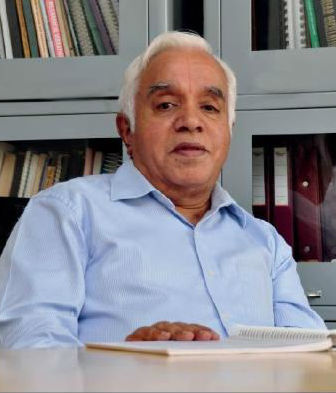 Professor R.N. Iyengar B.E., M.Sc(Eng)., Ph.D., (b. 1943) is renowned for his contributions to Earthquake Engineering, Random Vibrations, Mathematical Modeling, Structural Dynamics and Nonlinear Systems. As faculty at Indian Institute of Science from 1969 till his retirement in 2005 as KSIDC Chair Professor in Civil Engineering, Iyengar has published 200 technical papers, reports, general articles and books. He is Fellow of the Indian National Academy of Engineering, Indian Academy of Science, National Academy of Science and the Alexander von Humboldt Foundation, Germany. He held the Distinguished Schmidt Chair at the Florida Atlantic University, USA in 1995. He was Director of CBRI-CSIR (1994-2000); Raja Ramanna Fellow of Dept. of Atomic Energy (2005-10). After establishing the Centre for Disaster Mitigation with a unique Fire Research Lab, he is currently Distinguished Professor and the Director of the Centre for Ancient History & Culture at the Jain University, Bangalore.
Professor R.N. Iyengar B.E., M.Sc(Eng)., Ph.D., (b. 1943) is renowned for his contributions to Earthquake Engineering, Random Vibrations, Mathematical Modeling, Structural Dynamics and Nonlinear Systems. As faculty at Indian Institute of Science from 1969 till his retirement in 2005 as KSIDC Chair Professor in Civil Engineering, Iyengar has published 200 technical papers, reports, general articles and books. He is Fellow of the Indian National Academy of Engineering, Indian Academy of Science, National Academy of Science and the Alexander von Humboldt Foundation, Germany. He held the Distinguished Schmidt Chair at the Florida Atlantic University, USA in 1995. He was Director of CBRI-CSIR (1994-2000); Raja Ramanna Fellow of Dept. of Atomic Energy (2005-10). After establishing the Centre for Disaster Mitigation with a unique Fire Research Lab, he is currently Distinguished Professor and the Director of the Centre for Ancient History & Culture at the Jain University, Bangalore.
Prof. Iyengar is the recipient of Visvesvaraya award (Govt. of Karnataka, 1995); Technology Day award (Govt. of India 2001); Sen Memorial Lecture award (IIT Kharagpur 1996); and the VASVIK award (2013) for significant contributions to Structural and Mechanical Sciences & Technology.
Combining Indic knowledge traditions with modern methods, Prof. Iyengar has developed new lines of study of ancient Indian heritage. His findings on comets, eclipses, earthquakes, ancient geography, effect of precession and the Polestar Dhruva in Vedic literature, have attracted worldwide attention. He brought out Parāśaratantra, an ancient Sanskrit treatise on astronomy and natural sciences, with text, translation and notes in 2013. In 2018, he edited, with introduction, translation and notes, Nāradaśilpaśāstra, an ancient treatise of Civil Engineering which extensively deals with town-planning, construction of roads, dams, lakes, private and public buildings including marriage halls, art galleries, theatres and temples.
Abstract of the lectures
India has engineering marvels not only of palaces and temples but also of bridges, dams, water tanks, irrigation structures, spread across the length and breadth of the country. If the Bronze Age towns of the Harappan civilization are awe-inspiring, so are the bamboo bridges of North-East India, the stepwells of Gujarat and the palaces of Rajasthan. One gets mesmerized by the monumental temples built of brick, stone, terracotta, and even chiseled out of hills. One cannot help wondering how such large-scale engineering feats were achieved by our ancients. A formidable knowledge system of practice realized in the field and a theory enshrined in large number of Sanskrit texts is an achievement of universal acclaim. Not only in the ideals of architecture but also in the paradigms of town planning, water management, roads and bridges, traditional civil engineering provided a sophisticated civilization dimension to Indian heritage that is to be celebrated and emulated by modern engineers. A panoramic personal view of Civil Engineering in India from the remote past to pre-modern period will be presented in these two lectures.